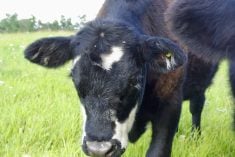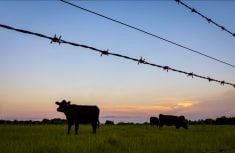Picture the cow you have just discovered with a rotting, maggot-filled cancer eye, or one with an eye injury that has popped the eye out. No doubt your first response is “We’ve got to do something for this poor animal!” Why? Well, not only because they present a gruesome sight, but more so because we know how eyes are extremely sensitive to pain.
Surely an eyeball bouncing on the end of an optic nerve has got to be an excruciating pain. And yet we often don’t feel that way about the more common, mundane eye diseases in cattle.
Read Also

Body condition, nutrition and vaccination for brood cows
One of the remarkable events of the past century related to ranching has been the genetic evolution of brood cows….
Most cattle producers will recognize “pinkeye” very quickly since it is the most common bovine eye ailment. This bacterial infection of the cornea and surrounding tissues only occurs if the eye first has been irritated in some manner. Flies can accomplish this irritation remarkably well. They not only irritate the eye, but they also carry the bacteria from cow to cow (like from your neighbors herd to yours). Other irritants include long, mature grass (“headed out”), dust, and some viruses. Though this is usually a summer- time condition, winter outbreaks of pinkeye do occur, and are typically associated with rubbing due to lice or mange. Immunity does develop in a herd; however, it is interesting to see how the disease often cycles through a herd periodically. Usually the young stock are affected worst, and sometimes in both eyes.
When you are checking cattle on pasture, you won’t be looking for pink eyes. Instead, when an affected cow turns her head to look at you, you will be faced with a dripping, cloudy grey and evil-looking eye. In the very early stages, the eye is squinting and dripping tears, but very quickly the cornea becomes cloudy. If left untreated, many will eventually develop ulcers on the cornea. In severe cases the eyeball ruptures through the ulcer and the soft tissues within the eye can prolapse to from a knoblike lump on the eye. Typically there is enough of a pain stimulus to cause significant decrease in milk production and weight gain.
Ease of handling clearly is an important factor in determining how to treat these cases. Treating a cow on community pasture is obviously more problematic than the 4-H calf in the barnyard. In outbreak situations you may want to first discuss treatment options with your vet to determine what the most effective route is for you to follow. In general, treatment should consist of the following:
Antibiotics. In mild cases where the animal is easily handled, a topical ointment or spray administered daily for four or five days will usually be adequate. For more severe cases it is better to administer a subcutaneous (under the skin) injection of a long-acting tetracycline antibiotic and repeat the injection in three days. This treatment will prevent the animal from becoming a carrier of the bacteria after it has recovered. Another option is to have your veterinarian inject penicillin, with or without an anti-inflammatory into the lining of the eye globe.
Eye protection/shade. Pinkeye is an extremely painful condition when the eye is exposed to bright sunlight. It is important to either place the animal in a shaded site (under a roof) or to glue a patch of cloth or a commercial patch over the eye. In severe cases your vet can suture the third eyelid to cover the eye, or suture the eyelids together to keep the eye clean, shaded and moist for seven to 14 days.
Anti-inflammatory medication. Most producers do not use much in the way of pain relief for these cases. I would suggest that the treatment response is quicker if an anti-inflammatory drug is used at least for a couple of days. If no improvement is seen after several days of treatment, you need to reassess the condition. It could be that there is a grass seed, or other foreign body in the eye.
It could also be that the condition is not pinkeye at all. IBR, and some infections that run through the bloodstream (septicemia), can cause both eyes to cloud over much like pinkeye. Have your vet look at any cases that resist treatment.
Prevention is, of course, a preferable route. If treatment sounds very time-consuming or tedious, it definitely can be, especially in outbreak situations. Adequate prevention means above all, good fly control. Insecticides administered via insecticide ear tags (especially if one is placed in each ear) back rubbers/oilers or pour-on fly control products are all very effective at reducing the numbers of flies landing around the eyes. Minimizing irritation from long grass by clipping the pastures and minimizing dust by avoiding overgrazing also helps. Lice, mites and other external parasites are easily controlled by the pour-on deworming products commonly used on farms.
Think about the last time you got a bit of grass seed or dust in your eye and all of the discomfort that caused. Not much else matters until you get that cleared out of your eye. For good economic reasons, reducing milk loss or weight loss, as well as on humane grounds, prevention and treatment of pinkeye is definitely warranted.















